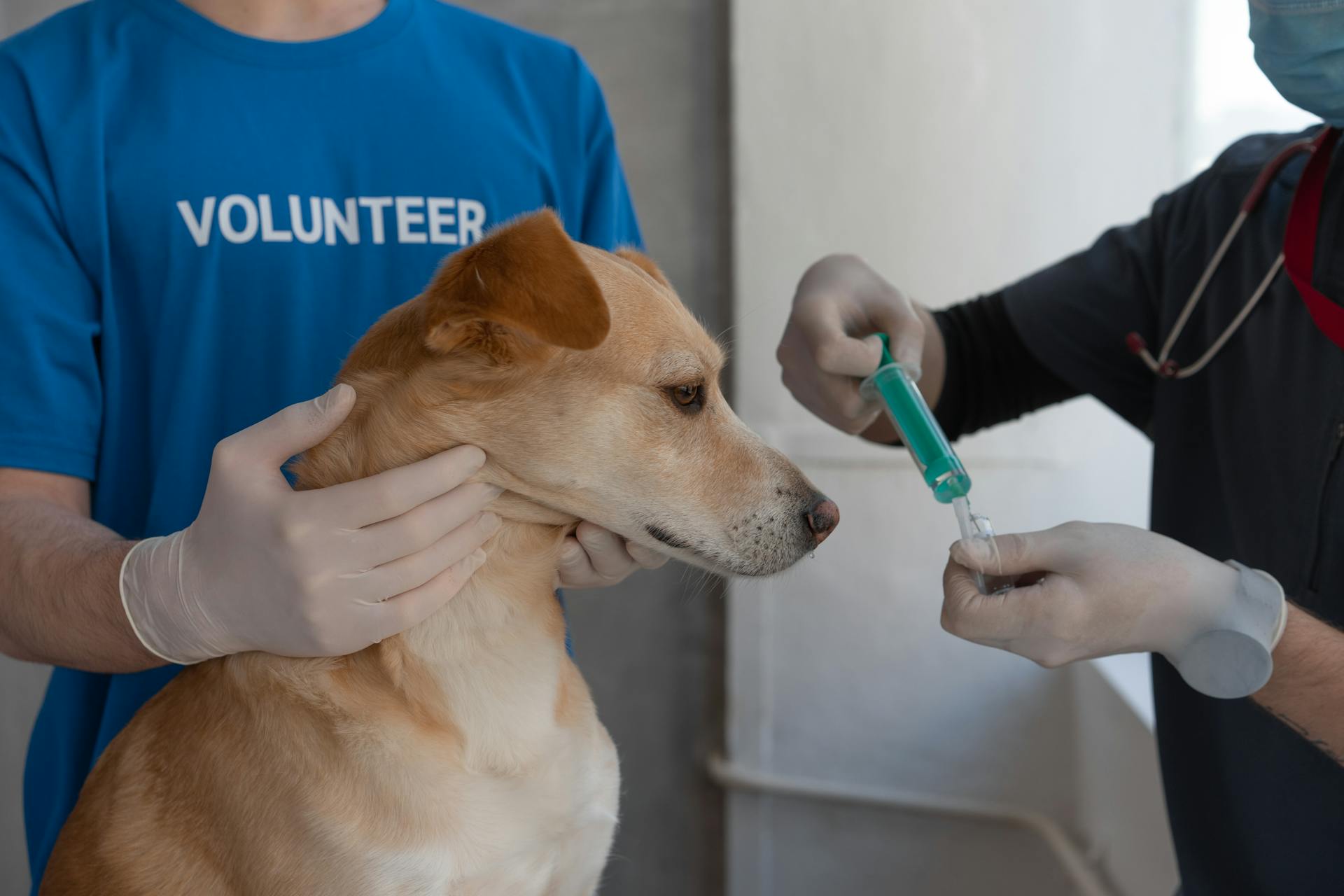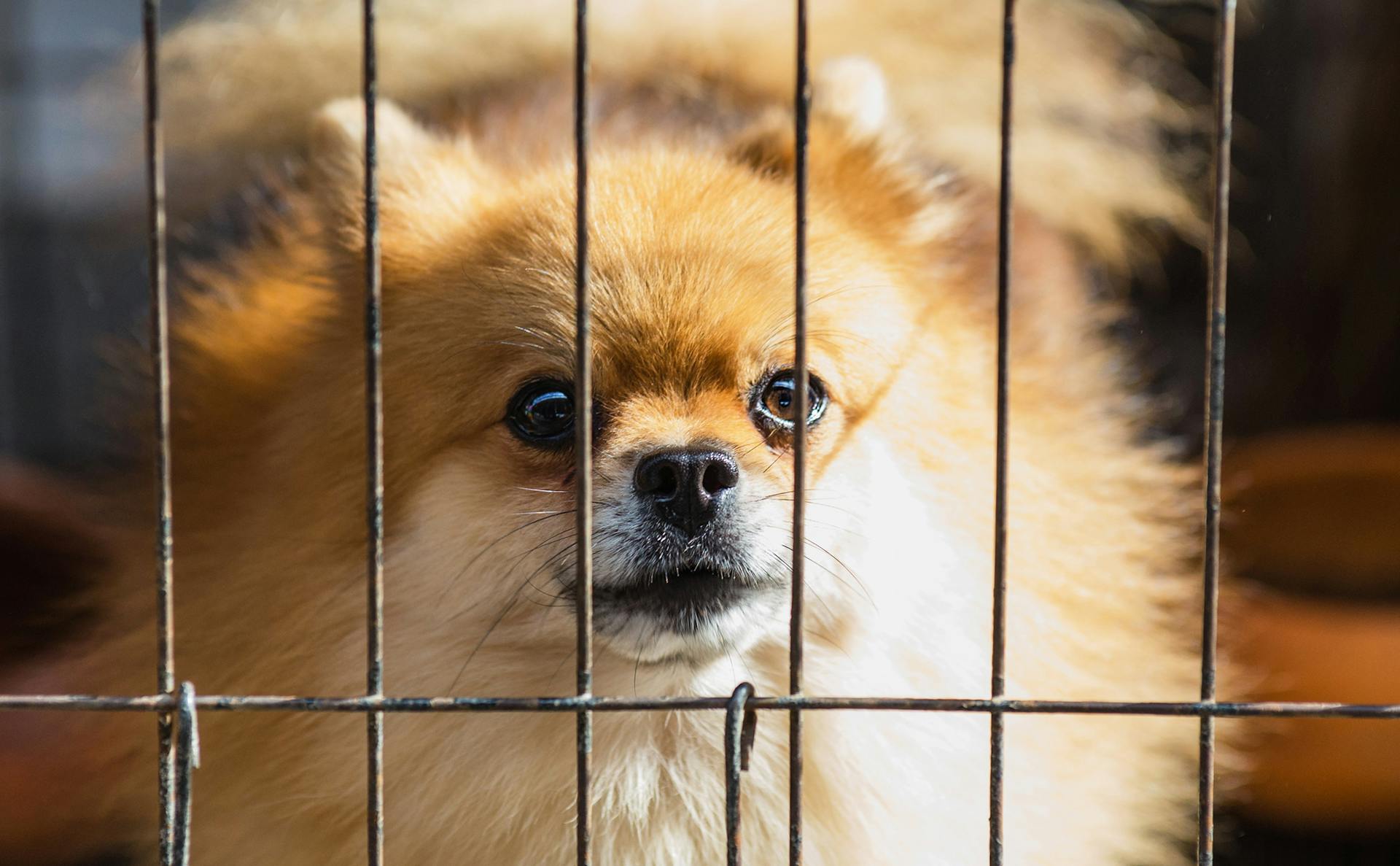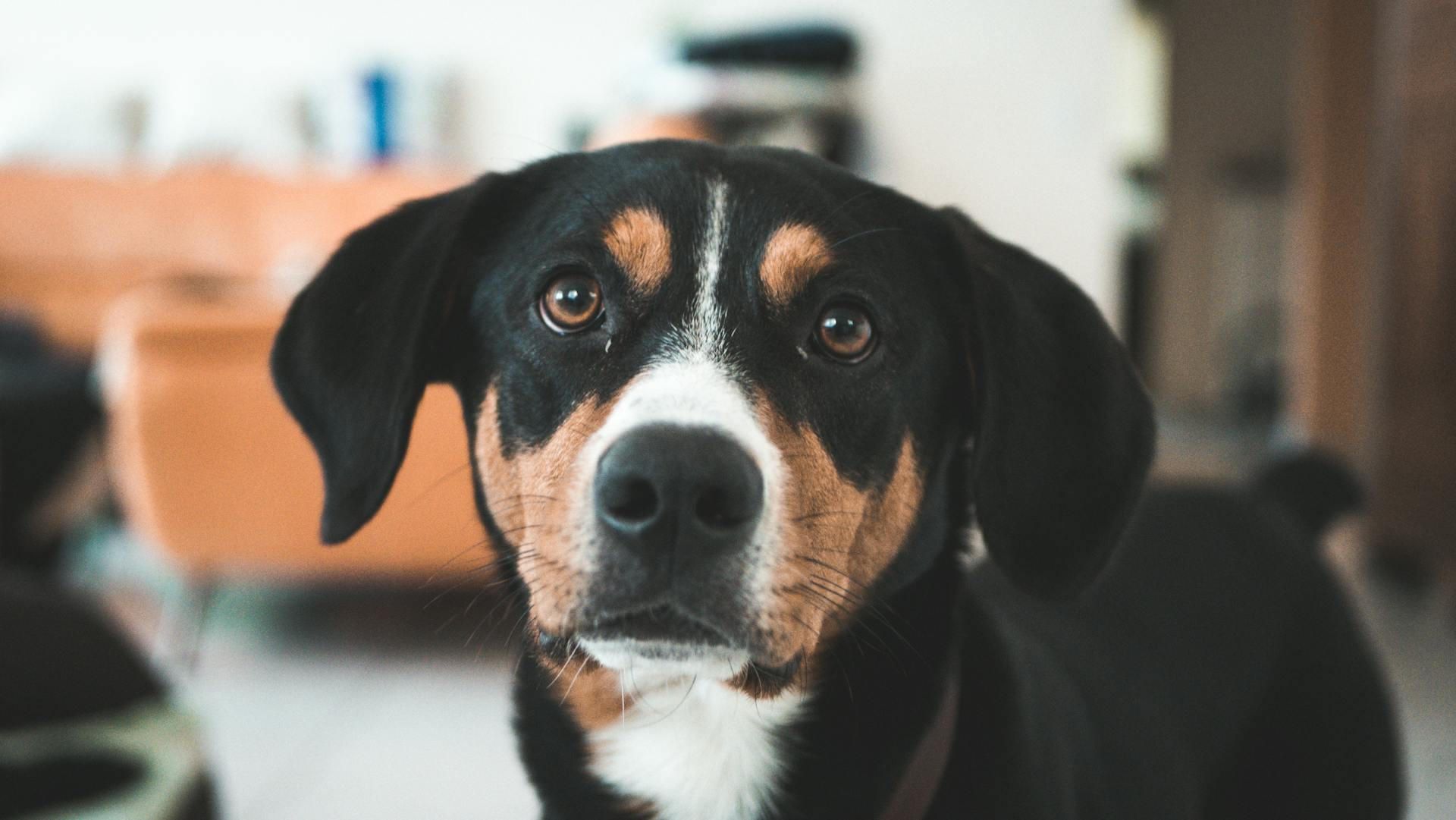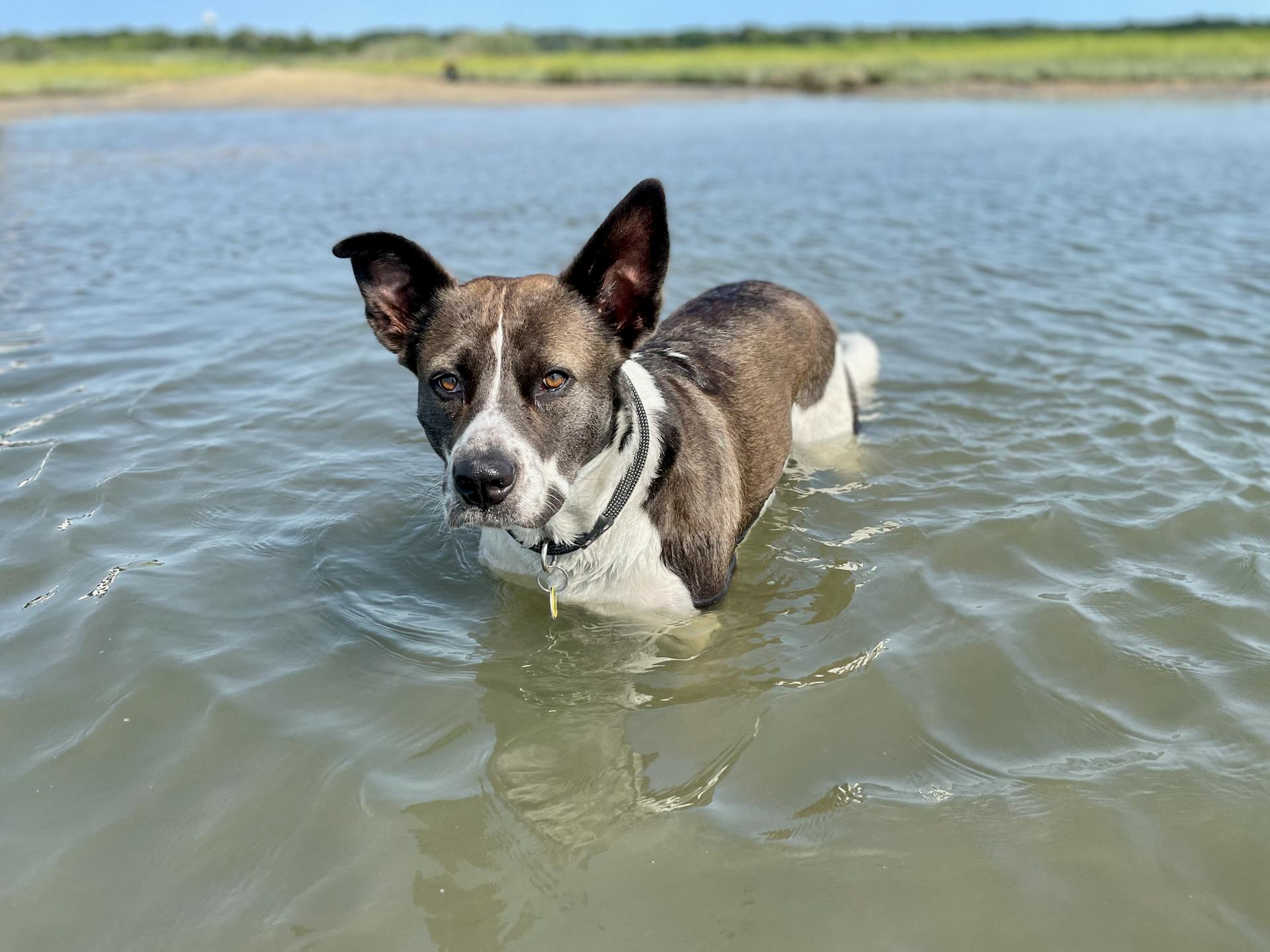
The canine parvovirus family is a group of viruses that primarily affect dogs.
There are several strains of canine parvovirus, including CPV-2a, CPV-2b, and CPV-2c.
Vaccination is a crucial tool in preventing the spread of canine parvovirus.
The first canine parvovirus vaccine was developed in the 1970s.
What Causes Infection?
The canine parvovirus family is a group of viruses that can infect dogs, and understanding what causes infection is crucial in preventing the spread of the disease.
The virus that causes parvovirus infection, canine parvovirus type 2 (CPV), first emerged among dogs in Europe around 1976.
Puppies and adolescent dogs are especially susceptible to parvovirus, and they should be kept away from public places where there is likely to be lots of virus until after their vaccinations are complete.
CPV is closely related to feline panleukopenia virus (FPV), a virus that has been known since the 1920s to infect cats and mink and other animals.
Discover more: Can Dogs Drink Cold Water in Summer
Every unvaccinated dog, irrespective of their breed and age, is capable of becoming infected by parvo.
The lack of options to get puppies vaccinated and dogs boostered during the COVID-19 pandemic caused a sudden spike in parvo cases across the globe.
Outbreaks of CPV are still quite common, and vaccinating your dog or puppy against canine parvovirus is a must.
Infection Process
The infection process of canine parvovirus is a complex and rapid one. It begins when a dog is exposed to parvovirus via fecal material from an infected dog, or through contact with contaminated surfaces or objects.
The virus then enters the dog's body and begins to multiply, targeting rapidly dividing cells in the tonsils or lymph nodes of the throat. This usually happens within three to seven days before symptoms appear.
Once in the bloodstream, the virus seeks out other rapidly dividing cells, particularly in the bone marrow and small intestines. In very young puppies, the virus can also infect the heart, causing inflammation of the heart muscle and poor heart function.
Worth a look: Canine Heart Cancer
The virus causes severe damage to the small intestine by targeting the epithelial surface, which is responsible for absorbing nutrients and preventing fluid loss and bacterial invasion. This leads to severe diarrhea and nausea, and can eventually cause the intestinal surface to break down, allowing bacteria to enter the bloodstream.
Here are the most hard-hit areas of the dog's system:
- Bone marrow
- Cells that line the walls of the small intestines
- Heart (in very young puppies)
Infection
Infection can occur through contact with fecal material from an infected dog, even if there's no visible feces. This can happen through the environment, such as the ground or surfaces, or through objects that have come into contact with an infected dog.
The virus that causes parvovirus, CPV, can survive for a long time outside of a host, making it easy to spread. The virus is highly contagious and can be transmitted through contact with an infected dog's feces.
Puppies and adolescent dogs are especially susceptible to parvovirus, and it's crucial to avoid taking them to public places where there may be a lot of virus, such as animal shelters and kennels, until their vaccinations are complete.
You might like: Canine Distemper Vírus
Every unvaccinated dog, regardless of breed or age, can become infected by parvovirus. This is why vaccinating your dog is so important, especially during outbreaks.
The incubation period for parvovirus is typically 3 to 7 days before symptoms appear. During this time, the virus is multiplying inside the dog's body, making it difficult to detect.
CPV outbreaks are still quite common and can occur throughout the year. This is why it's essential to keep your dog's vaccinations up to date and to be aware of the risks of parvovirus infection.
Incubation
The incubation period of parvovirus is a critical stage in the infection process. It can last anywhere from three to seven days.
During this time, the dog is infected but not yet showing symptoms. The virus is busy multiplying and seeking out its next targets.
The virus specifically targets rapidly dividing cells in the body, which are typically found in the tonsils or lymph nodes in the throat. This allows it to multiply effectively and efficiently.
Once the virus has multiplied and entered the bloodstream, it will seek out other sources of rapidly dividing cells. These areas are often the most hard-hit.
The bone marrow and cells that line the walls of the small intestines are particularly vulnerable to the virus. In very young puppies, the virus can also infect the heart, leading to inflammation, poor heart function, and arrhythmias.
Symptoms and Complications
Symptoms of canine parvovirus can be quite distressing for both you and your furry friend. Lethargy, depression, and loss or lack of appetite are common early signs, often followed by a sudden onset of high fever, vomiting, and diarrhea.
A dog with parvovirus will usually start to show symptoms within three to seven days of infection. Early signs include lethargy, lack of appetite, and fever.
As the virus progresses, your dog may begin to experience abdominal pain, vomiting, and diarrhea. These symptoms can be a real challenge to manage, especially if your dog is vomiting or having bloody diarrhea.
If this caught your attention, see: Diabetes in Dogs Vomiting
Very sick puppies with parvovirus may collapse, have a high heart rate, have difficulty breathing, have low white blood cell (WBC) counts, be hypothermic, or be hypoglycemic. These severe symptoms can be life-threatening if not addressed promptly.
Here are some of the common symptoms of canine parvovirus:
- Lethargy
- Lack of appetite
- Fever
- Abdominal pain
- Vomiting
- Diarrhea
- Collapse
- High heart rate
- Difficulty breathing
- Low white blood cell (WBC) counts
- Hypothermia
- Hypoglycemia
Diagnosis and Treatment
The most common method of testing for canine parvovirus is the fecal ELISA test, which can usually be completed by your veterinarian in less than 15 minutes. This test is fairly accurate, but it can occasionally produce false positive or false negative results, so further testing may be necessary to confirm a diagnosis.
A low white blood cell count is often a key indicator of CPV infection, as the virus attacks the bone marrow and reduces the production of WBCs drastically.
Supportive care is the current standard of care for treating canine parvovirus, which involves extensive hospitalization due to severe dehydration and potential damage to the intestines and bone marrow.
Recommended read: Canine Brucellosis Test
The treatment for canine parvovirus typically includes:
- Hospitalization with intravenous fluids
- Antiemetics to stop vomiting
- Focusing on nutrition, with a feeding tube, if necessary
- Correction of any electrolyte imbalances or low blood glucose
- Some vets may also recommend treatment with a canine parvo monoclonal antibody (CPMA)
There is no guaranteed cure for canine parvovirus, and the survival rate depends on how quickly the virus is diagnosed and treated, as well as the age of the dog and the aggressiveness of the treatment.
Tests Needed for Diagnosis
The most common and convenient method of testing for CPV is the fecal ELISA test, which can usually be completed by your veterinarian in under 15 minutes.
This test is fairly accurate, but it can occasionally produce false positive or false negative results, so further testing may be necessary to confirm a diagnosis.
A fecal PCR test is also available, which detects small pieces of viral DNA specific to CPV in the stool of an infected dog. This test is very accurate but requires sending a fecal sample to a laboratory that specializes in PCR-based testing.
A simple measure of white blood cell count is often the clincher for a CPV diagnosis, as parvovirus infects the bone marrow and can cause a low white blood cell count.
Readers also liked: Canine Parvovirus Test
A low white blood cell count, combined with a positive ELISA reading, can suggest a fairly confident diagnosis of CPV.
Veterinarians may also recommend a PCR test, which is more sensitive than a rapid antigen test or ELISA, and can detect the CPV viral particles (DNA) highly specific to canine parvovirus type 2.
A combination of a positive CPV faecal test on PCR and a low WBC count is often a confirmed canine parvo diagnosis.
Recommended read: Canine Distemper Test
Treatment
Treatment for canine parvovirus is a serious matter that requires immediate attention. Hospitalization is often necessary to provide intravenous fluids and nutrients to replace lost fluids due to vomiting and diarrhea.
The goal of treatment is to support the dog's body in fighting off the virus. Supportive care includes intravenous fluids, antibiotics to fight secondary bacterial infections, and medications to control nausea and diarrhea.
Puppies with severe dehydration may require blood transfusions to boost low blood cell counts. Antibiotics may also be necessary to prevent sepsis, a life-threatening condition caused by bacterial infections.
A fresh viewpoint: Canine Cancer Treatment

The cost of treatment can range from several hundred to several thousand dollars, depending on the severity of the illness and the length of hospital stay. It's essential to note that prevention through vaccination is much more cost-effective than treatment.
Here's a summary of the treatment options:
The treatment duration can vary from 2-14 days, depending on the severity of the illness. It's crucial to work closely with a veterinarian to determine the best course of treatment for your dog.
Broaden your view: Canine Leishmaniasis Treatment
Prevention and Vaccination
Vaccination is a must for protecting your dog against canine parvovirus (CPV). The CPV vaccine is usually administered as part of a combination shot that includes other vaccines, such as distemper, canine adenovirus, and parainfluenza vaccines.
Puppies should receive their first CPV vaccine at 6 weeks old, with booster shots given every 3 to 4 weeks until they are at least 16 weeks old. A booster vaccination is recommended one year later, and then every three years thereafter.
The most important thing for preventing parvo is making sure you get your puppy in on time for their vaccines. Puppies should only socialize with fully vaccinated dogs until they are able to be fully vaccinated themselves.
Dogs need to receive a booster vaccine at 1 year of age to be considered fully vaccinated. They should also continue to receive vaccines every one to three years for life or have their immunity monitored using parvovirus antibody tests.
Prevention is the only way to ensure that a puppy or dog remains healthy, as the disease is extremely virulent and contagious. Appropriate vaccination should be performed starting at 7-8 weeks of age, with a booster given every 3-4 weeks until at least 16 weeks old.
You can protect your puppy from canine parvo by following the standard vaccination protocol, which includes multiple shots up until 16 weeks of age. Don't forget to give yearly boosters to your dog to protect them from CPV infection.
The only household disinfectant that kills the virus is bleach, and a dilute bleach solution of 1 part bleach to 30 parts water is an acceptable method for disinfecting any indoor area that once housed an infected dog.
Consider reading: How to Work Out Dog Years
Here are some key vaccination and prevention tips:
- Get your puppy vaccinated on time and follow the standard vaccination protocol.
- Give yearly boosters to your dog to protect them from CPV infection.
- Do not take unvaccinated puppies outside until they are at least 120 days old and have received their Puppy DP, DHPPiL Vaccine and booster.
- Do not let strangers cuddle your unvaccinated puppy.
- Isolate any dog that is infected with CPV from other dogs to prevent the spread of the disease.
Recovery and Management
Recovery from parvovirus in dogs can take quite a while, often five to 10 days after symptoms begin, and varies case by case. Full recovery may take a while depending on the severity of the disease and the damage it has done.
Dogs recovering from a parvo infection need a bland, easily digestible diet to help their intestines heal. Prescription veterinary diets like Hill's Science Diet, Purina, and Royal Canin are carefully formulated to be nutritionally balanced and gentle on the GI tract.
Hospital stays for parvo typically last around five to seven days, but this can vary depending on the severity of symptoms. The highest risk of death occurs around 24–72 hours after symptoms appear.
If a parvo puppy is hospitalized, given lots of supportive care, and monitored closely, the survival rate is usually around 85–95%. Survival is more difficult if the dog is not given veterinary attention quickly after showing clinical signs or if the dog is not hospitalized with sufficient supportive care.
Additional reading: Symptoms of Canine Cancer
Here are some prescription veterinary diets that may be recommended for dogs recovering from parvo:
- Hill's Prescription Diet Digestive Care i/d dry dog food
- Hill's Prescription Diet Digestive Care i/d wet dog food
- Purina Pro Plan Veterinary Diets EN Gastroenteric dry dog food
- Purina Pro Plan Veterinary Diets EN Gastroenteric wet dog food
- Royal Canin Veterinary Diet Gastrointestinal Low Fat dry dog food
- Royal Canin Veterinary Diet Puppy Gastrointestinal dry dog food
- Royal Canin Veterinary Diet Gastrointestinal Low Fat wet dog food
CPV Overview
Canine parvovirus, also known as CPV, is a highly contagious and serious virus that affects dogs. It's hard to kill and can live for a long time in the environment, making it a significant threat to canine health.
The CPV virus is primarily spread through direct dog-to-dog contact, contact with contaminated stool, and contaminated surfaces. It can also be spread through people who have come into contact with infected dogs and haven't washed their hands or clothes.
The virus has an incubation period of about a week, during which an infected dog may not show any symptoms. If you suspect your dog or puppy has been exposed to CPV, it's essential to visit a vet hospital and request a parvo test.
Here are some ways the virus can spread:
- Direct dog-to-dog contact
- Contact with contaminated stool
- Contaminated surfaces
- People who have come into contact with infected dogs (unwashed hands and clothes)
- Contaminated food and water bowls
- Infected leashes, collars, and other accessories
What Is?
Canine parvovirus, commonly referred to as parvo, is an infectious DNA virus that primarily affects young and unvaccinated dogs.

It's a highly contagious virus that can spread through direct dog-to-dog contact, contaminated stool, surfaces, and even people who have come into contact with infected dogs.
The virus is hard to kill and can live for a long time in the environment, making it a serious threat to canine health.
Parvo was discovered in the 1970s and has since become a major concern for dog owners, especially those with puppies.
The parvovirus vaccine is considered a core vaccine for puppies and dogs, and it's highly effective in preventing the virus.
However, parvo is still widely prevalent, especially in puppies and poorly vaccinated adolescent dogs.
The virus has a 7-day incubation period, during which an infected dog or puppy won't show immediate symptoms.
Here's a breakdown of how the virus spreads:
- Direct dog-to-dog contact
- Dog's contact with contaminated stool
- Contaminated surfaces that contain the viruses
- People who have come in touch with infected dogs (unwashed hands and clothes)
- Contaminated food and water bowls
- Infected leashes, collars, and other accessories
It's essential to take precautions to prevent the spread of parvo, such as thoroughly cleaning floors, furniture, and accessories if your dog has tested positive for the virus.
Variants
There are two main types of canine parvovirus: CPV1 and CPV2. CPV2 causes the most serious disease.
The two main strains of CPV2 are CPV-2a and CPV-2b, which were identified in 1979 and 1984 respectively. These strains have largely replaced the original strain and are the cause of most canine parvovirus infections.
CPV-2c is a variant of CPV2 that has a unique pattern of antigenicity, making it different from the other two strains. This variant was discovered in Italy, Vietnam, and Spain.
The existing CPV vaccines based on CPV-2b provide adequate levels of protection against CPV-2c. This is good news for dog owners, as it means their pets are still protected against the more recent strain of the virus.
Certain breeds, such as Rottweilers, Doberman Pinschers, and Pit bull terriers, as well as black and tan colored dogs, may be more susceptible to CPV2. This means they may be at higher risk of severe infection.
Dogs infected with parvovirus usually die from dehydration or secondary infection, rather than the virus itself. This is a serious reminder of the importance of seeking veterinary care if you suspect your dog has been exposed to parvovirus.
Conclusion

CPV campaigns can be a game-changer for advertisers looking to target high-value customers.
The benefits of CPV are clear: advertisers can reach their target audience with precision, increasing the likelihood of conversion.
With a cost-per-view model, advertisers only pay for the ads that are actually viewed, making it a cost-effective option.
By focusing on the most relevant and high-value keywords, advertisers can maximize their ROI and drive real results.
In conclusion, CPV is a powerful advertising strategy that can help businesses achieve their goals.
Intriguing read: Diabetes in Dogs Cost
Frequently Asked Questions
What family and genus is parvovirus?
Parvovirus belongs to the family Parvoviridae, specifically the genera Dependovirus and Parvovirus. The Parvovirus genus contains a single disease-causing strain, while Dependoviruses require a helper virus for replication.
What type of virus is canine parvovirus?
Canine parvovirus is a type of autonomous parvovirus similar to viruses that affect cats and minks. It's a highly contagious virus that causes severe gastrointestinal illness in dogs.
Can canine parvovirus spread to humans?
No, humans cannot catch parvovirus from their dogs. However, it's essential to prevent cross-contamination to other dogs and environments to avoid spreading the infection.
What are the two subfamilies of Parvoviridae?
The two subfamilies of Parvoviridae are Parvovirinae and Densovirinae, which infect vertebrates and invertebrates respectively. This distinction is key to understanding the viruses' behavior and impact on different organisms.
Sources
- https://www.vet.cornell.edu/departments-centers-and-institutes/baker-institute/research-baker-institute/canine-parvovirus
- https://www.petmd.com/dog/conditions/infectious-parasitic/parvo-in-dogs
- https://en.wikipedia.org/wiki/Canine_parvovirus
- https://vetic.in/blog/pet-health/what-is-canine-parvo-prevention-symptoms-causes-diagnosis-and-treatment/
- https://laboklin.com/en/parvoviruses_in_dogs_and_cats/
Featured Images: pexels.com


